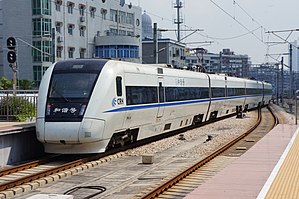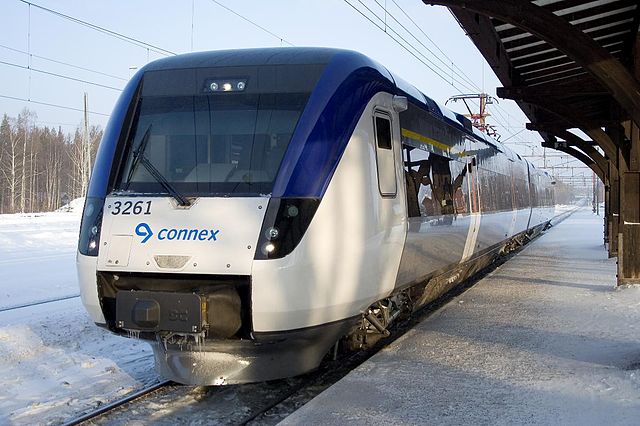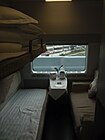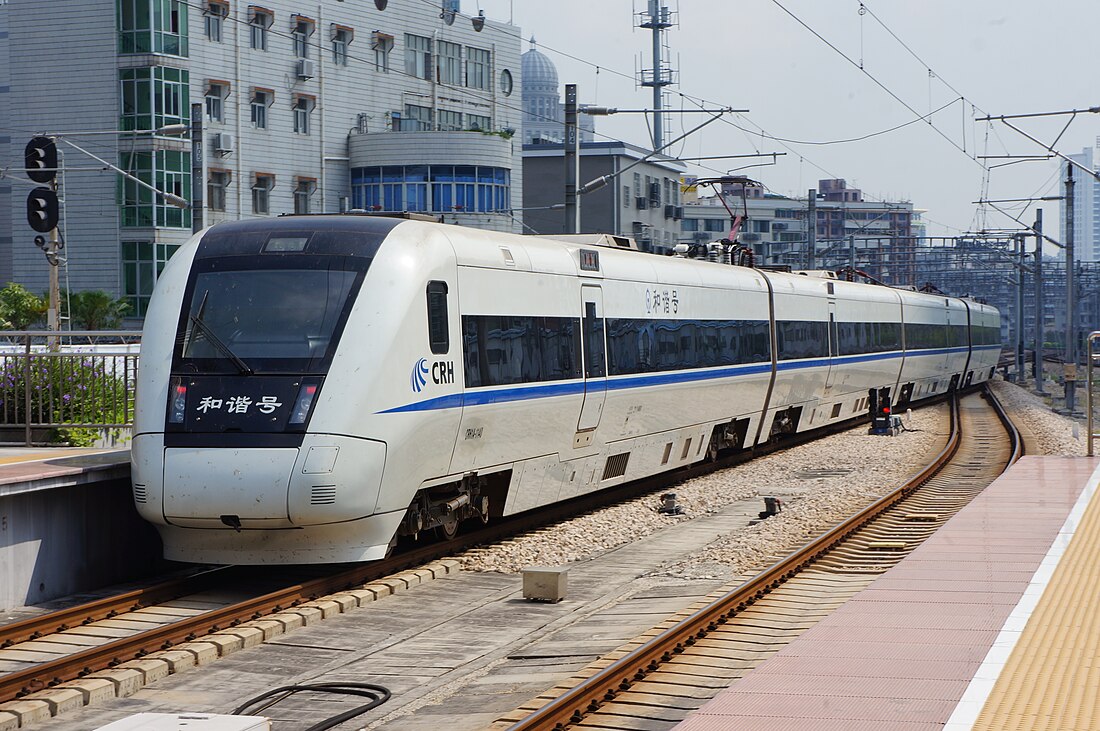The CRH1 EMU, also known as Hexie (simplified Chinese: 和谐号; traditional Chinese: 和諧號; pinyin: Héxié Hào; lit. 'Harmony'), is a high-speed train operated by China Railway and built by a joint venture between Bombardier Transportation and Sifang at Bombardier Sifang Power Transportation factory in Qingdao, Shandong Province, People's Republic of China.
This article needs additional citations for verification. (December 2007) |
| China Railways CRH1 EMU | |
|---|---|
 CRH1A at Xiamen railway station | |
| In service | 1 February 2007–present |
| Manufacturer | Bombardier Sifang (Qingdao) Transportation Ltd. (Bombardier Transportation and CSR Sifang) |
| Family name | Regina Zefiro |
| Number built | CRH1A: 128 trainsets (1024 cars) CRH1A–A: 87 trainsets (696 cars) CRH1B: 24 trainsets (384 cars) CRH1E: 15 trainsets (240 cars) CRH1E–NG: 5 trainsets (80 cars) CRH380D: 85 trainsets (680 cars) |
| Formation | CRH1A/A–A: eight cars per trainset (5M3T) CRH1B/E/E–NG: 16 cars per trainset (10M6T) CRH380D: eight cars per trainset (4M4T) |
| Capacity | CRH1A: 668 or 611 or 646 or 635 CRH1A–A: 613 CRH1B: 1299 CRH1E/E–NG: 618 or 642 CRH380D: 495 |
| Operators | China Railway - CR Guangzhou - CR Shanghai - CR Nanchang - CR Chengdu |
| Lines served | High speed and major conventional rail lines in southern China |
| Specifications | |
| Car body construction | CRH1A/B/E: Stainless Steel CRH1A–A/E–NG/380D: Aluminium Alloy |
| Train length | CRH1A: 213.5 m (700 ft 6 in) CRH1A–A: 207.9 m (682 ft 1 in) CRH1B: 426.3 m (1,398 ft 7 in) CRH1E: 428.9 m (1,407 ft 2 in) CRH1E–NG: 413.1 m (1,355 ft 4 in) CRH380D: 215.3 m (706 ft 4 in) |
| Platform height | 500–1,250 mm (1 ft 7.7 in – 4 ft 1.2 in) |
| Maximum speed | CRH1A:200 km/h (124 mph)or 250 km/h (155 mph) CRH1A–A/B/E/E–NG:250 km/h (155 mph) CRH380D: 380 km/h (236 mph) |
| Weight | CRH1A/A–A:435 t (428 long tons; 480 short tons) CRH1B:850 t (837 long tons; 937 short tons) CRH1E/E–NG:890 t (876 long tons; 981 short tons) CRH380D:450 t (443 long tons; 496 short tons) |
| Traction system | Water cooling IGBT-VVVF inverter control (Bombardier MITRAC 1000)[1][2] |
| Traction motors | 3-phase AC induction motor (Bombardier DR-1200 [CRH1A] or DR-1500 [CRH1B/E]) |
| Power output | CRH1A: 5.3 MW (7,107 hp) CRH1A–A: 5.5 MW (7,376 hp) CRH1B/E/E–NG: 11 MW (14,751 hp) CRH380D: 10 MW (13,410 hp) |
| Transmission | AC-DC-AC |
| Acceleration | CRH1A/B/E:Maximum 0.6 m/s2 (1.3 mph/s) CRH380D: 0.48 m/s2 (1.1 mph/s) |
| Deceleration | CRH1A:Emergency 1.2 m/s2 (2.7 mph/s) General 0.8 m/s2 (1.8 mph/s) |
| Electric system(s) | 25 kV 50 Hz AC Overhead catenary |
| Current collector(s) | Pantograph |
| Braking system(s) | Regenerative, electronically controlled pneumatic brakes |
| Track gauge | 1,435 mm (4 ft 8+1⁄2 in) standard gauge |
At the same time as ordering the Shinkansen-based CRH2A and the Pendolino-based CRH5A, the Chinese Ministry of Railways ordered Bombardier-based CRH1, specifically 20 CRH1A trainsets in June 2007 and an additional 20 CRH1A trains, each with eight cars that have total standard capacity of 670 people. The total value of the order is €560 million.[3] In July 2010, a further 40 CRH1A eight-car trains were ordered.[4]
Variants


CRH1A
CRH1A and CRH1B are based on Bombardier's Regina family.[5] The train was designed by Sifang and Bombardier jointly in Västerås, Sweden and originally named C2008.[3][5]
Each CRH1A set consists of eight cars, the first batch (CRH1-001A~CRH1-040A) including two first class coaches (ZY), 5 second class coaches (ZE) and 1 second class coach/dining car (ZEC).the second batch (CRH1-081A~CRH1-120A) including two first class coaches (ZY), one first class/second class coaches (ZYE), four second class coaches (ZE) and 1 second class coach/dining car (ZEC). The potential maximum speed of CRH1A is 250 km/h (155 mph), but in fact the maximum speed of the initial 40 sets in operation is always restricted by the software of computer control system, so the maximum speed in service is 220 km/h (137 mph).
The first units (CRH1-001A) were delivered on August 30, 2006,[6] the CRH1A sets started service from February 1, 2007 at the Guangzhou -Shenzhen Railway. The 2 problems of this train is that this train is made out of stainless steel, so when the train go through tunnels, the passenger with have some ear sensitivity. This train had been given a nickname, big metro. The seats can't turn around, so half of the passengers have backward seats. The only good thing is that having fixed chairs with have more space, so CRH1A has can carry the most people.
In July 2010, the Chinese MOR ordered additional 40 sets of CRH1A, The designed top operating speed increased to 250 km/h (155 mph), In September 2010, during test run at Qinshen PDL, top speed of CRH1-081A reach 278 km/h (173 mph).[7]
From July 1, 2014, all CRH series EMU numbers have been changed. The original number is (CRH1—xxxA), and now it is changed to (CRH1A-1xxx). Production EMUs after that date are in accordance with the new regulations.
CRH1A-A
- CRH1A-A at Chaoshan railway station
- CRH1A-A First Class
- CRH1A-A second class
In September 2012, The MOR issued a revision in the Zefiro contract, which calls for the order of an additional 106 eight car Zefiro 250 (46 sets) and Zefiro 250NG (60 sets) train sets in lieu of the cancellation of the 16 car Zefiro 380 sets. The NG variant is a new model, which will use new materials in order to achieve weight reductions and more efficient operation.[8]
CRH1B
On October 31, 2007, the Chinese MOR ordered 20 sets of CRH1B trains (CRH1-041B~CRH1-060B). CRH1B is a fleet-extended CRH1A. Each CRH1B consists of 16 cars, including three first class coaches (ZY), 12 second class coaches (ZE) and one dining car (CA). CRH1B, however, have not such restriction on the operational speed, the maximum speed is still 250 km/h (155 mph). CRH1B first come into commercial use in April 2009, between Shanghai–Nanjing & Shanghai–Hangzhou.[9]
On July 23, 2011, CRH1-046B was hit on ZY104600 car by CRH2-139E in Yongtaiwen PFL accident.
CRH1E
On October 31, 2007, the Chinese MOR ordered 20 sets of CRH1E trains (CRH1-061E~CRH1-080E). The CRH1E is the first high-speed 16-car sleeper train (10M6T) in the world which is based on Bombardier's ZEFIRO 250 km/h (155 mph) design. The train was designed by Bombardier and Zagato. Each train set from the first 12 trainsets consists of one luxury sleeper (WG), 12 soft sleepers (WR), two second-class coaches (ZE), and one dining car (CA). The first CRH1E trainset delivered in October 2009, first came into service on November 4, 2009, between Beijing–Shanghai. In fact, only 15 CRH1Es were delivered, three of which had the luxury sleeper replaced with normal sleepers. The other five ended up being CRH1Bs, this time based on the CRH1E design (instead of CRH1A). Later on five additional CRH1Es (based on the CRH1A-A design) have also been manufactured and delivered.[9]
- CRH1E
- Two CRH1 series E high-speed trains in Shanghai Hongqiao Railway Station
- Leisure area of CRH1E
- Deluxe Sleeper Compartment of CRH1E
CRH1E-NG

CRH1E-NG (NG=New Generation), or CRH1E-250 was introduced in December 2015 as supplemental trains to the first-generation CRH1E. The head shape resembled similar to the CRH1A-A, which also belongs to the Bombardier ZEFIRO platform. In addition, the original stainless steel body was changed to an aluminum alloy body to improve the air tightness of the car body. The train consists of 16 cars with 10 motors and 6 tractors and a power of 11,000kW. The maximum operating speed is 250km/h, and the maximum test speed is 280km/h.
CRH1E-NG is designed as a sleeper EMU, mainly running at night, but in actual situations, it will run some short-distance EMUs (it once carried the train numbers D2348 and D2347). Therefore, the soft sleeper berth of the CRH1E-NG EMU has an adjustable seat design, and the bed board of the upper bunk is changed to a flip-up design that can be lifted upward. A backrest cushion is added to the side wall of the lower bunk bed, and a hidden pull-down armrest is designed between the cushions. A 4-person soft sleeper private room can be converted into a 6-person soft seat private room.
At the same time, the CRH1E-NG EMU has also added some humanized facilities: for example, the even-numbered carriages are equipped with three toilets, and the lighting is optimized. In order to avoid unnecessary waste, the original CRH1E dining car (CA) was changed to a dining car with soft sleepers (WRC).
CRH380D

The CRH380D is also derived from the Bombardier Zefiro family (Zefiro 380) of very high-speed EMUs and are not direct derivatives of the Regina type trains from which the CRH1A and CRH1B classes are derived. This is the only high-speed rail that doesn't have a 16-car version without connecting 2 trains into 1.[10] Top speed is advertised at 380 km/h (236 mph).[11] The eight-car version is designated CRH380D, series number CRH380D-1501 ~ CRH380D-1585.[8]
Formation
|
Power Destination
|
Coach Type
|
- car door
- First Class Coach.
- Interior of a second class coach.
- second class coach/buffet car (ZEC)
CRH1A & CRH1A–A
CRH1A-1081~1085, 1091~1093, 1105, 1110~1116, 1120, and CRH1A-1121~1166, information is currently missing.
CRH1B
CRH1E
CRH380D
Distribution
As of April 2018, 260 CRH1 series EMU and 85 CRH380D series EMU are in service.
See also
References
External links
Wikiwand in your browser!
Seamless Wikipedia browsing. On steroids.
Every time you click a link to Wikipedia, Wiktionary or Wikiquote in your browser's search results, it will show the modern Wikiwand interface.
Wikiwand extension is a five stars, simple, with minimum permission required to keep your browsing private, safe and transparent.











